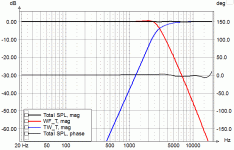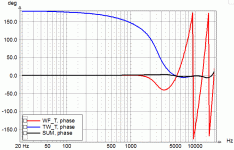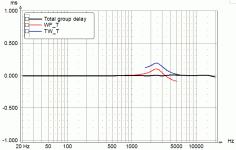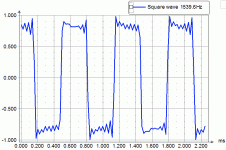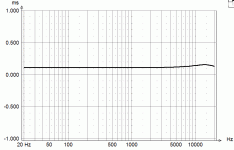Originally Posted by bentoronto
silly to try to aim to get phase anywhere right
No, not if want to get Everything as good as possible !
*don't laugh, but I've often pointed that in setting the polarity of sub which are located anywhere but under the mids, often impossible to decide by ear what is the right phase. And with a mic, you need to pick between two curves that are not clearly with one curve better.
I'm laughing
Marketing and selling applies only on commercial field, not DIY. I was referring to commercial loudspeakers (some B&W's comes to my mind), not DIY loudspeakers (Troels Gravesen included). I have great respect for the work of Mr. Gravesen.I'm not sure. Troels Gravesen has a couple of designs that use physical offsets but are not time co-incident. I think it can help remove a pole or two in order to get accurate phase alignment.
Yes, physical offset may improve a design if it is used wisely. Or make it worse if it is used only for the appearance.
Yes, 1st order high-pass on the tweeter AND 1st order low-pass on the woofer. But there are some very good approximations with higher order filters, there are threads on that issue here in this forum.AFAIK, in order to get true time / phase coincident in a multi-way speaker you not only need the physical offset, but you also need to use a 1st order HP on the tweeter.
Time alignment by either delay or physical offset only works on axis. There are several reasons. First, you are correcting for the offset of the acoustic centers of the drivers. But where is the acoustic center? On axis we assume, reasonable, that it is on the driver's axis. But what about off axis? At 45* off axis where is the AC? Still on the driver's axis? All you can say is that relative to some distance the phase response reduces to minimum phase and the excess phase can be accounted for by a delay. But that delay isn't even the same because the response off axis is difference than on axis and the minimum phase will also be different. So not only is delay or offset a "one dimensional" correction applied to a 3-D problem, but the 3-d corrections would (is) position dependent.
AFAIK, in order to get true time / phase coincident in a multi-way speaker you not only need the physical offset, but you also need to use a 1st order HP on the tweeter.
Best,
E
There are many other way to generate them.
Time alignment....but the 3-d corrections would (is) position dependent.
Right. That post should finally put the phase issue to bed.
Granted you can't do much about phase unless listeners' heads are held in place with a bite-board. But do you agree that you can make the gross time alignment somewhat better? And should do so unless the "cost" in complexity, distortion, etc. exceeds the benefit?
Of course, it is easy to imagine geometries where the delay is helpful and geometries where it isn't helpful.
B.
Member
Joined 2009
Paid Member
Set-back vs. allpass delay? I use both for best results, that is, transient-perfect crossovers.
There's one thing allpasses can do that a physical delay cannot: add a slope to the group delay and this slope can be made positive (when the Q value is greater than 0.58/Bessel), increasing group delay with frequency.... until a very high frequencies the group delay falls again to eventually reach zero.
A proper positive GD slope can compensate for the falling GD response of a high-pass, and together with a true set-back this can be trimmed to give a GD/Phase result that yields a linear-phase mid-to-tweeter XO with rather steep slopes and good summing (non-destructive addition).
The example shown below is for a 3kHz TPXO, 4th order slopes on both sections. The set-back accounts for 50us (1.7cm) of offset and the allpass cascade (6th order) does another 50us with a rising slope which peaks at 14kHz, their combined effect on GD (without XO) is shown in the last plot.
Phase difference for this XO is 90deg and quite constant in the core XO region, so it is to be used with symmetrical arrangement, M-T-M.
For the plots the observation point had to be delayed by 158us. Phase is then within a +-10deg margin right up to 20kHz.
There is some "time smear" (very high freqs are ahead of lower ones) because of the finite response of the allpasses but this is located in the ultrasonic range so it's no big deal.
There's one thing allpasses can do that a physical delay cannot: add a slope to the group delay and this slope can be made positive (when the Q value is greater than 0.58/Bessel), increasing group delay with frequency.... until a very high frequencies the group delay falls again to eventually reach zero.
A proper positive GD slope can compensate for the falling GD response of a high-pass, and together with a true set-back this can be trimmed to give a GD/Phase result that yields a linear-phase mid-to-tweeter XO with rather steep slopes and good summing (non-destructive addition).
The example shown below is for a 3kHz TPXO, 4th order slopes on both sections. The set-back accounts for 50us (1.7cm) of offset and the allpass cascade (6th order) does another 50us with a rising slope which peaks at 14kHz, their combined effect on GD (without XO) is shown in the last plot.
Phase difference for this XO is 90deg and quite constant in the core XO region, so it is to be used with symmetrical arrangement, M-T-M.
For the plots the observation point had to be delayed by 158us. Phase is then within a +-10deg margin right up to 20kHz.
There is some "time smear" (very high freqs are ahead of lower ones) because of the finite response of the allpasses but this is located in the ultrasonic range so it's no big deal.
Attachments
Time alignment by either delay or physical offset only works on axis. There are several reasons. First, you are correcting for the offset of the acoustic centers of the drivers. But where is the acoustic center? On axis we assume, reasonable, that it is on the driver's axis. But what about off axis? At 45* off axis where is the AC? Still on the driver's axis? All you can say is that relative to some distance the phase response reduces to minimum phase and the excess phase can be accounted for by a delay. But that delay isn't even the same because the response off axis is difference than on axis and the minimum phase will also be different. So not only is delay or offset a "one dimensional" correction applied to a 3-D problem, but the 3-d corrections would (is) position dependent.
That's an explanation as succinct as I've ever heard regarding this.
Thanks John.
Dave.
Is the square wave a mic pick-up or what? What about frequencies besides 1539.6 Hz, like 1300 or 1700?The example shown below is for a 3kHz TPXO, 4th order slopes on both sections...
B.
IMO there is multiple equally good ways to achieving the "same" goal of having drive units sum at some point in space in the way we like it best and these are well known. Achieving phase delay mechanically or electronically works in either case. I prefer my drivers on a flat baffle with assymetrical XO filters. This is the simplest way for me to arrive at a satisfactory result than with other means.
I recently started to use asymmetrical crossovers as well. The ones that I use are behaving a little better than an LR and a little worse than BW in terms of power response and a little worse than LR and a little better than BW in terms of lobing. And they have less group-delay distortion than both, LR and BW.
The latest setup is a large MTM with two 15" woofers and a horn. Because of the mechanical offset of the horn the woofers have to be delayed. I could have done this with allpass filters without problems of course. But I decided to use a Bessel lowpass for that purpose to achieve the necessary delay (together with the woofer's inherent lowpass function, which is also causing some delay !). Delaying a woofer electronically is definitley an easier task than delaying a tweeter - simply due to the bandwidth involved.
I will also test with a classic time-aligned crossover (high order Bessel lowpass and lower order highpass) and also with some special subtractive topology which should give almost perfect transient response at the cost of less steep slopes. But I would never use a first order crossover !
Using a forth order crossover and group delay equaliser like KSTR is using, would mean a very high order allpass chain for my crossover frequency. But I have once used this method with a small coaxial that was crossed-over at 1.5 kHz using my low GD asymmetrical X-over.
Regards
Charles
The latest setup is a large MTM with two 15" woofers and a horn. Because of the mechanical offset of the horn the woofers have to be delayed. I could have done this with allpass filters without problems of course. But I decided to use a Bessel lowpass for that purpose to achieve the necessary delay (together with the woofer's inherent lowpass function, which is also causing some delay !). Delaying a woofer electronically is definitley an easier task than delaying a tweeter - simply due to the bandwidth involved.
I will also test with a classic time-aligned crossover (high order Bessel lowpass and lower order highpass) and also with some special subtractive topology which should give almost perfect transient response at the cost of less steep slopes. But I would never use a first order crossover !
Using a forth order crossover and group delay equaliser like KSTR is using, would mean a very high order allpass chain for my crossover frequency. But I have once used this method with a small coaxial that was crossed-over at 1.5 kHz using my low GD asymmetrical X-over.
Regards
Charles
- Status
- This old topic is closed. If you want to reopen this topic, contact a moderator using the "Report Post" button.
- Home
- Loudspeakers
- Multi-Way
- tweeter set-back vs all-pass delay
